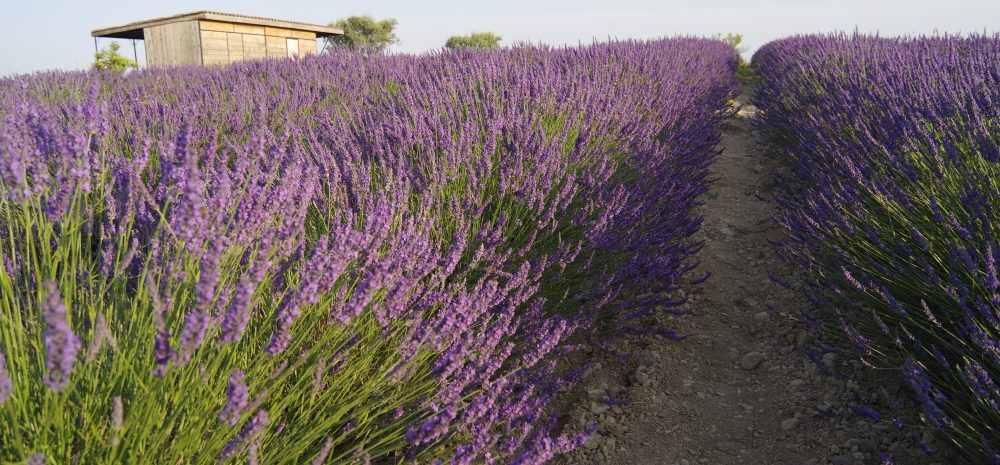
Lavender essential oil is more commonly known as lavender extract or lavender essence.
Lavender, from the Latin name Lavandula Angustifolia, was already used by the Romans to perfume baths.
It wasn’t until the 18th century that naturalist Carl Von Linné gave the plant the name “Lavender”.
Lavender in Valensole
The variety we grow on our plateau is lavender officinalis, also known as “fine lavender”. This variety grows at altitudes of 600 meters and higher.
It takes around 130 kg of flowers to distill 1 liter of essential oil. In good years, 1 hectare of plantation can produce up to 50 liters of essential oil.
Recognizing it among lavender can be tricky. To tell them apart, you have to get up close.
Lavender is small and has a single flower on each stem, its bloom is lighter and its spikes are ruffled.
Lavender is a member of the Lamiaceae family, like thyme, sage…
There are 28 varieties of lavender worldwide.
Distillation methods
Distilling a plant involves passing steam through the flower to extract its essential oil.
The pre-cut lavender flower is placed in a vat through which steam flows, extracting the flower pistil which contains the essential oil. The steam-gasoline mixture rises in the swan neck, then cools in the coil. After condensation, it becomes liquid again. The essential oil then rises to the surface, as it is lighter than water.
The essencier is fitted with two taps: the higher one collects the
essential oil
and the lower one for removing the distilled water – the hydrolat.
The process is exactly the same as for lavandin.
Once again, there are two ways of distilling:
The conventional method: crushed flowers and stems are rapidly distilled.
The traditional method: cut stems and flowers are not crushed; they are collected after at least a day’s drying in the fields and then distilled.
50% of the world’s lavender essential oil is produced in France.
Calming, sedative, antidepressant, hypotensive, relaxing, powerful analgesic and anti-inflammatory, antibacterial, antiviral, diuretic, digestive stimulant, immune system stimulant. Regenerating, healing and stimulating for the skin. For muscular pains and contractures.

Migraines and headaches: Place a few drops on the temples and massage gently.
Insomnia and sleep disorders: Put 3.4 drops on the pillow before going to sleep.
Sore throat: Swallow 3 drops of lavender essential oil with a spoonful of honey.
Blocked nose: pour boiling water into a stable container. Add about 5 drops of essential oils. Wait one or two minutes before inhalation. Make yourself comfortable and bring your face up to the vapors, and breathe for about ten minutes.
Stress and nervous breakdowns: we recommend putting between 10 and 15 drops of essential oil in the bath.
Sunburn: 3.4 drops of lavender essential oil diluted in a vegetable cream.
Mouth abscess, gingivitis: 1 ml lavender essential oil + 1 ml bay laurel essential oil mixed with 10 ml St. John’s wort vegetable oil. Gently massage the area to be treated with your mixture. 3 times a day for 3 days.
Many other uses are possible.
One of the most versatile essential oils. If you had to have just one at hand, it would undoubtedly be this one. It is very useful for treating a wide variety of problems.
Lavender is edible.
In some allergy-prone people, lavender can cause skin irritation or inflammation. So don’t forget to test on your own skin before any major use.




Our main activity is the growing of lavender and lavandin, a family history with us for four generations. For years we have been pioneers in organic farming and recognised for the high quality of our work.
It was during a family meal in 2015 that the idea of distributing our products directly came to us. Until then, we had been selling our produce to wholesalers or agricultural cooperatives.
So it was on this impetus that myself, Samuel (22) and my partner Emma (20) decided to devote ourselves to this crop full-time, leaving the production side to my father so that everyone had all the space they needed to best develop their part of the business.
Our main activity is the growing of lavender and lavandin, a family history with us for four generations. For years we have been pioneers in organic farming and recognised for the high quality of our work.
It was during a family meal in 2015 that the idea of distributing our products directly came to us. Until then, we had been selling our produce to wholesalers or agricultural cooperatives.
So it was on this impetus that myself, Samuel (22) and my partner Emma (20) decided to devote ourselves to this crop full-time, leaving the production side to my father so that everyone had all the space they needed to best develop their part of the business.